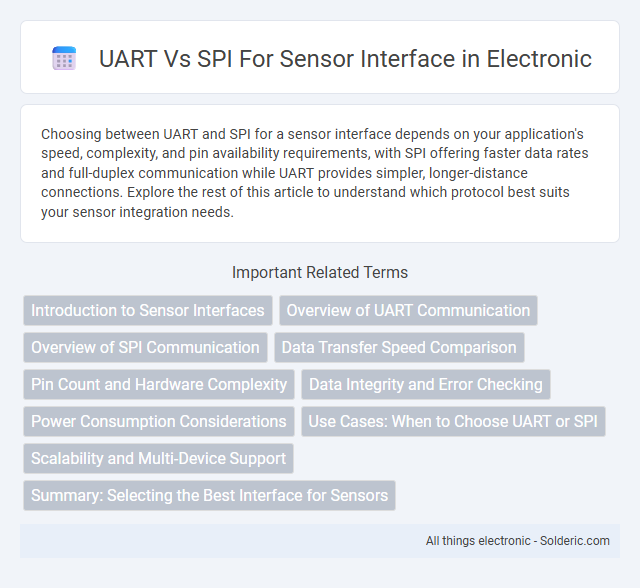Choosing between UART and SPI for a sensor interface depends on your application's speed, complexity, and pin availability requirements, with SPI offering faster data rates and full-duplex communication while UART provides simpler, longer-distance connections. Explore the rest of this article to understand which protocol best suits your sensor integration needs.
Comparison Table
| Feature | UART | SPI |
|---|---|---|
| Full Name | Universal Asynchronous Receiver/Transmitter | Serial Peripheral Interface |
| Communication Type | Asynchronous Serial | Synchronous Serial |
| Data Lines | 2 (TX, RX) | 4 (MOSI, MISO, SCLK, SS) |
| Speed | Up to 1 Mbps (typical) | Up to 50 Mbps (depends on hardware) |
| Clock | No clock line (self-timed) | Requires clock line (SCLK) |
| Data Transfer | Half or full duplex | Full duplex |
| Complexity | Simple wiring, less pins | More pins, complex wiring |
| Number of Devices | Supports point-to-point or multiple devices with multiplexers | Multiple devices supported with separate SS lines |
| Use Case in Sensors | Low speed, simple sensor data | High speed, real-time sensor data |
| Power Consumption | Lower power, less overhead | Higher power due to clock and multiple lines |
Introduction to Sensor Interfaces
UART and SPI are common protocols used for sensor interfaces, each offering distinct advantages based on application needs. UART provides a simple, two-wire serial communication ideal for low-speed, point-to-point connections, while SPI supports higher-speed, full-duplex data transfer with multiple slave devices through a master-slave architecture. The choice between UART and SPI depends on factors like data rate, complexity, and the number of sensors involved in the system design.
Overview of UART Communication
UART communication is a widely used serial protocol that enables asynchronous data exchange between sensors and microcontrollers through two bidirectional lines: transmit (TX) and receive (RX). It operates without a clock signal, relying on start and stop bits to frame data, making it suitable for simple, low-speed sensor interfaces where full-duplex communication is essential. Your sensor's choice of UART interface ensures straightforward wiring and ease of integration, particularly in systems requiring long-distance communication with minimal pin usage.
Overview of SPI Communication
SPI communication operates as a high-speed, full-duplex serial interface using separate lines for clock (SCLK), master out slave in (MOSI), master in slave out (MISO), and chip select (CS). It supports multiple slave devices with individual chip select signals, providing faster data rates ideal for sensor applications requiring rapid and continuous data transfer. Unlike UART, SPI lacks standardized framing or error checking, relying on hardware-level synchronization for reliable sensor data communication.
Data Transfer Speed Comparison
SPI offers significantly higher data transfer speeds compared to UART, often reaching up to tens of megabits per second, ideal for high-speed sensor data communication. UART speeds are typically limited to a few megabits per second, constrained by asynchronous transmission and start/stop bit overhead. SPI's synchronous clock-driven protocol enables faster, more reliable data throughput essential for real-time sensor applications.
Pin Count and Hardware Complexity
SPI offers lower pin count by using a shared clock and data lines, typically requiring four pins (MISO, MOSI, SCLK, and SS) for full-duplex communication, while UART demands only two pins (TX and RX) but lacks a clock line. Hardware complexity for SPI increases due to the need for precise clock management and multiple chip select lines for each sensor, whereas UART's asynchronous design simplifies hardware integration at the cost of potential synchronization issues. Your choice depends on balancing the simplicity of UART's minimal pin usage against SPI's efficient multi-sensor support despite its greater hardware complexity.
Data Integrity and Error Checking
SPI offers higher data integrity for sensor interfaces due to its full-duplex communication and built-in clock signal that ensures synchronized data transfer, reducing the chance of errors. UART relies on asynchronous data transfer with start and stop bits, making it more susceptible to noise and timing errors without additional error-checking mechanisms like parity bits. To ensure your sensor data remains accurate, choosing SPI provides a more robust error checking and integrity assurance compared to UART.
Power Consumption Considerations
UART interfaces typically exhibit lower power consumption compared to SPI due to simpler hardware requirements and reduced clocking activity, making UART suitable for low-power sensor applications. SPI communication demands continuous clock signaling and multiple active lines, which can increase power usage, particularly in high-frequency data transfers. Optimizing sensor interface selection for power-sensitive designs involves balancing UART's energy efficiency against SPI's higher throughput capabilities.
Use Cases: When to Choose UART or SPI
UART is ideal for low-speed, long-distance communication with simple wiring and minimal pin usage, making it suitable for sensors that require asynchronous data transfer and less frequent updates. SPI excels in high-speed, short-distance communication with simultaneous full-duplex data exchange, preferred for sensors needing rapid, continuous data streaming or multiple device connections with precise timing. Choosing UART benefits battery-powered or resource-constrained systems, while SPI is optimal for complex sensor networks requiring fast, reliable data transfer.
Scalability and Multi-Device Support
SPI offers superior scalability and multi-device support compared to UART by enabling multiple sensors to share a single bus through chip select lines, facilitating simultaneous communication. UART typically supports only point-to-point connections, making it less efficient when interfacing with several sensors. Your choice should consider SPI's capacity for handling complex sensor networks versus UART's simpler, limited device connectivity.
Summary: Selecting the Best Interface for Sensors
UART and SPI are both common interfaces for sensor communication, but SPI offers higher data transfer speeds and better support for multiple sensors through its multi-slave architecture. UART is simpler and requires fewer pins, making it ideal for low-speed or point-to-point connections. Your choice depends on sensor data rate requirements and system complexity, with SPI favored for high-performance designs and UART suitable for straightforward, low-bandwidth applications.
UART vs SPI for sensor interface Infographic

 solderic.com
solderic.com